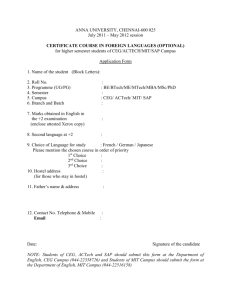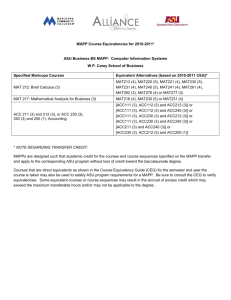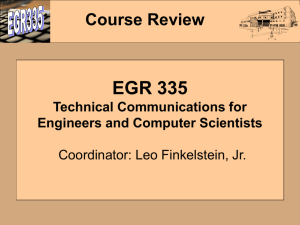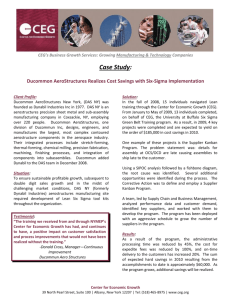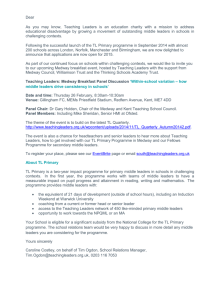Establishing World Class Careers Education and Guidance in Connexions Kent & Medway:
advertisement
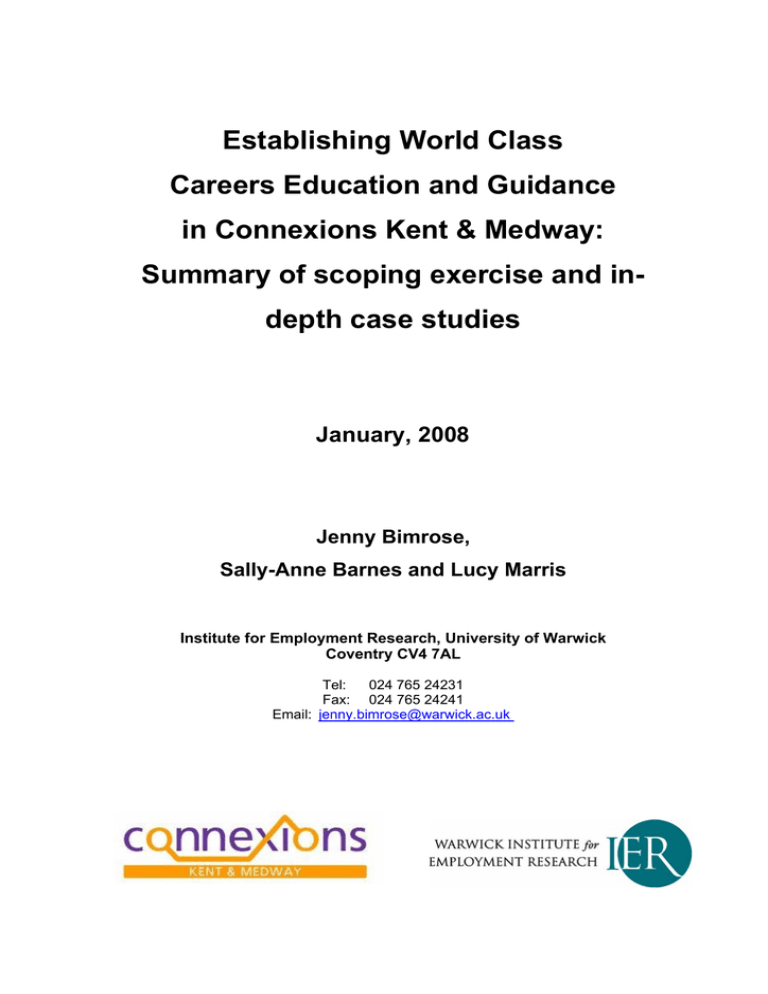
Establishing World Class Careers Education and Guidance in Connexions Kent & Medway: Summary of scoping exercise and indepth case studies January, 2008 Jenny Bimrose, Sally-Anne Barnes and Lucy Marris Institute for Employment Research, University of Warwick Coventry CV4 7AL Tel: 024 765 24231 Fax: 024 765 24241 Email: jenny.bimrose@warwick.ac.uk TU UT Disclaimer It should be noted that views expressed in this document are not necessarily those of Connexions Kent & Medway, or indeed any of the schools in the Kent and Medway region. Acknowledgements Warwick Institute for Employment Research would like to thank Connexions Kent & Medway for the opportunity to complete this work. Sincere thanks go to Gordon Bernard, Chief Executive, David Milton, Head of Partnership Development and Rebecca Towner, Guidance Development Officer, who have provided constant support, together with practical information and help. Additionally, special thanks go to the school staff who gave generously their time during the two phases of the research. Specifically, this includes: Abbey School Francis Hatt, Acting Deputy Head Angley School Richard Haupt, Assistant Headteacher Ashford Christ Church Heather de Souza, Head of Community Hillview School for Girls David Wallace, Careers and Business Partnership Manager Hugh Christie Technology College Marion Seymour, teacher, with responsibility for Social Inclusion Maidstone Grammar School for Girls Jon Mallalieu, Assistant Director of Sixth Form and Careers Co-ordinator Jane Smith, Head Teacher John Paddon, Mini- Enterprise and Work Experience Co-ordinator Helen Thurrant, Cover Supervisor Marlowe Academy Audrey Ford, Team Leader for Support and Guidance Suzanne Oakley, Lead Teacher in Health and Social Care Dave Draper, Learning Support Unit Co-ordinator Liz Habbershaw, Team Leader Sixth Form Marsh Academy Tracy Luke, Academy Principal Jim Grant, Vice Principal Northfleet Technology College Joanne Bennett, Head of Key Stage 4 and Vocational Learning Cornelius Deyzel, Learning Support Unit Manager Celia Fox, SENCO Jan Ide, Learning Resource Centre Manager and Connexions library/P.A. liaison Oakwood Park Grammar School David Howells, Assistant Head of Middle School, Careers Co-ordinator, Work Experience Co-ordinator, and full time Maths Teacher Robert Napier School Charlotte Mathias, Enterprise, Work-Related-Learning and Careers Manager Sandwich Technology School Mark Beaman, Assistant Head Teacher and Director of Vocational Specialism Andrew Whatley, Assistant Head Teacher, Head of Sixth From Nicky Richardson, Key Stage 5 Manager, Careers and Work-related Learning Coordinator Aubrey Harris, Vocational Support Assistant New Line Learning – Senacre Technology College Julie Fearon, Enterprise Officer Swadelands School Madeleine Tilton, Science Teacher and Careers Co-ordinator, Work Experience Coordinator and Cache Co-ordinator Walmer Science College Andrew Milliken, Assistant Head Teacher in charge of sixth form as well as Information and Guidance Hilary Preidel, History Teacher (Head of Department) Westlands School Jenny Phillips, Careers and Work Experience Co-ordinator We are also indebted to the following Connexions Personal Advisers (P.A.s) who participated in this study: • Sharon Acaster • Vernice Lamberton • Viv Akrofi • Robyn McCormick • Rob Buchanan • Debbie Monger • Pam Childs • Lynette Morissy • Vanessa Cole • Jas Notay • Tracy Eastman • Patricia Pike • Jeanette Hamilton • Stephen Watering • Jeanneke Hodges • Melissa Whitehead • Angharad Johnson • Roger Wild Finally, particular thanks go to the 15 students from Years 11, 12 and 13 at different schools who took time out of their school day to participate in focus group discussions and give guided tours of their school – their willingness to share understandings and ideas was greatly valued. Introduction The Institute for Employment Research at the University of Warwick is working with Connexions Kent & Medway on a project to develop and implement an innovative approach to careers education and guidance (CEG) across the region. Overall, the project is designed to assist Connexions Kent & Medway service prepare for the impartial information, advice and guidance (IAG) that will be required to support curriculum changes such as the new Diplomas and comply with the Quality Standards for Young People’s Information, Advice and Guidance (IAG). It comprises four discrete, but inter-related work-packages: • A thorough review of its CEG provision in secondary schools, using a qualitative, in-depth case study approach; • Designing, testing and recommending an approach for sustainable e-portfolio development for career education and guidance across the region; • A feasibility study into the development of local labour market information for the region, available on-line; and • Developing a model of sustainable training support for the use of effective labour market information in the IAG process. This document relates to the first phase of the project – the review of CEG provision. Objectives of this phase are to: • Provide an in-depth account of CEG provision in schools throughout the region from the perspectives of key stakeholders involved in its delivery; and • Establish which critical success factors and strategies contribute to the delivery of coherent CEG services in the region. Two reports were produced: the first relates to the results of a telephone survey of provision in 15 schools; the second, to in-depth case studies undertaken in five schools. This document collates the executive summaries, conclusions and recommendations from these two reports 1 Executive summary This qualitative research into the provision of careers education and guidance (CEG) in the Kent and Medway region has provided rich and deep insights both to the strengths, and to the weaknesses, of current service provision. A telephone survey was undertaken across 15 schools, together with five in-depth case studies (four of which had participated in the telephone survey). In total, sixteen schools participated, representing a range of different types of school and located in different regional sites across Kent and Medway. Of the 48 participants in the research, 30 are school based staff and 18 are employed by Connexions Kent & Medway. Staff delivering CEG Whilst it was clear that all research participants shared a common purpose regarding their involvement with, and/or contribution to, the delivery of high quality CEG in the region, they occupied a wide variety of designations, offering very different types of experience and expertise. Connexions Lead Personal Advisers (P.A.s)/Team Leaders and Guidance P.A.s were more likely to have had prior experience of CEG, compared with school representatives. All had CEG related qualifications. Of the 18 school representatives responsible for CEG, the majority (n=17, 94%) did not hold any accredited CEG related qualifications. Of the 18 school representatives with responsibility for CEG within their schools who participated in the telephone survey, 11 (61%) had applied, volunteered or agreed to take on the responsibility of careers provision. The remaining seven (39%) had been allocated the responsibility. Seven (39%) of these same 18 school representatives had no time formally allocated to CEG. One had what was described as a reduced teaching load; one had about a 10 per cent time allocation and nine (50%) either had a formal allocation of time, or felt they were able to manage their time sufficiently well to discharge this responsibility. Of the 15 schools which participated in the telephone survey, ten had posts with some level of responsibility for CEG that were teaching posts; four schools had non2 teaching CEG posts; and one was in transition, with the future arrangement uncertain. The language of CEG A common language was generally used to describe CEG provision, but differences were highlighted in understandings of the terms used. The importance of clear, unambiguous terminology around CEG was emphasised by 62 per cent of participants (n=23). However, whilst there was a degree of consensus regarding the broad concepts used to describe CEG, there was less uniformity in the language used to describe its precise nature. Overall, an holistic understanding of CEG emerged, incorporating a range of activities across all year groups, with the term ‘careers’ recurrently featuring as a key concept. Much of the language of CEG is considered to be too complicated for many young people. Younger students typically demonstrated an embryonic understanding of the language, which developed over time, compared with older students who often demonstrated a broader and deeper understanding of terms like ‘career’. Terminology such as ‘careers education and guidance’ and ‘information, advice and guidance’, tended to be restricted to the Connexions Partnership Agreement and Delivery Plan, and discussions between careers professionals. Models of CEG provision Four distinct models of CEG provision in schools emerged from analysis of the data. These were: integrated; stand alone; peripheral; and transitional. A robust CEG model can accommodate, successfully, both curriculum integration and targeted, stand-alone elements, provided it responds to students’ needs at different key stages, with targeted inputs for each year group. This, importantly, includes personalised and tailored activities for students with particular learning needs, and/or those disengaged from the curriculum. Optimally, the expertise of school staff will both complement and enhance that of Connexions Kent & Medway employees, for the benefit of students. A breadth of delivery formats for CEG is evident, with each school tending to develop its own approach. However, some recurring trends are discernible. The practice of using ‘enrichment days’ contrasted with more traditional modes of delivery involving 3 shorter inputs of CEG (e.g. within PSHE) more consistently throughout the academic year is perhaps the most notable. Fully integrated CEG, seamlessly presented throughout the curriculum, with all staff sharing a sense of ownership for its inclusion is undoubtedly hard to achieve, but for many schools remains the ultimate aim of delivery. The socio-economic contexts in which schools operate needs to be taken into account in the provision of CEG services. Professional judgements by teaching staff of what is considered to be relevant provision will be strongly influenced by their perceptions of what will benefit their students and what fits with the school ethos. It is crucial, therefore, that services provided by Connexions Kent & Medway accommodate the schools’ aims and objectives as well as its own. Evidence-based practice Evidence-based practice is demanded by government of many publicly funded services. However, participants at eight of the schools (53%) had either very little awareness, or no idea at all, of the models underpinning existing their CEG provision. Eight schools reported a lack of any formal systematic evaluation procedures for their CEG programmes. Six schools reported evaluation procedures that were part of other processes, rather than undertaken as part of a systematic process of continuous quality improvement of their CEG provision. Only one school out of the 15 participating in the telephone survey reported how they undertook regular, systematic evaluations of their CEG. P.A.s seemed to be more likely than school staff routinely to evaluate their work. Whilst only three of the 15 schools surveyed had already achieved the Investor in Careers Award (IIC), six were intending to submit an application or were already in the process of submitting their application for this award. Six schools did not hold the award, nor were they interested in applying. Relationships between schools and Connexions Kent & Medway Thirteen of the fifteen schools surveyed regarded their relationship with Connexions as excellent, good, improving or having the potential to improve. For the remaining two schools, the current relationship between the service and the schools was 4 reported as poor, with participants expressing a degree of pessimism that this was likely to change in the near future. Effective partnership between Connexions Kent & Medway and schools in the region are likely to be developed and maintained through Partnership Agreements and Delivery Plans. Key factors are: effective working relationships; continuity of staff in both organisations; reflective practice; together with clear and constant communication. Further, integrating a shared understanding and vision for CEG and embedding the ethos of IAG into the Schools Improvement Plan and Schools Evaluation Form documents are likely to enhance any partnership agreement. Twelve schools surveyed indicated that they had both Partnership Agreements and Delivery Plans – and that these were generally useful. Three schools were either ambivalent about, or critical of, Partnership Agreements. In these cases, negative views of the Partnership Agreements related to their being regarded as tokenism. In ten of the 15 schools surveyed, either the Head Teacher and/or the Deputy Head involved themselves in the Partnership Agreements for their school. In three schools, Senior Managers from the school were involved, whilst in just two schools, no representative of school management were represented in the Partnership Agreement. Personal Advisers A crucial success factor in the delivery of high quality CEG services that has emerged recurrently in this research is the approach taken by the Connexions Kent & Medway P.A.s to working in the schools to which they are allocated. The number of P.A.s allocated to each school varied from between one and five. The particular package of services provided differed, as could be expected, across the schools surveyed. Exactly how individual P.A.s worked within their schools was dependent on a number of factors including: time allocation; case load; and the particular focus of the P.A.’s work (for example whether guidance, pre-vocational, intensive or health). Whilst some problems with P.A.s were certainly reported, feedback on the quality of relationships between P.A.s and schools was overwhelmingly positive. 5 In order that a high quality service, relevant to individual student need, can be delivered, P.A.s require easy access to student data. In 14 of the 15 schools surveyed, access to student data was not a problem. In one, however, gaining access to student data was problematic. The extent to which students make optimum use of services on offer will depend, at least in part, on the awareness of students that these services exist and an understanding of how they might access them. In only one of the 14 schools surveyed was the promotion of services thought to be sufficient and effective. Labour market information and careers library provision Labour market information (LMI) is critical to the objectives of CEG provision and is an integral part of guidance practice. However, time and resource constraints will determine how much LMI can be researched. Twenty participants (57%) indicated how LMI is both limited and not readily available. Thirteen participants (35%) undertook their own research for LMI. Nine participants commented on the P.A.st availability of LMI and its value. One school representative was not sure what LMI was available in the school. One other was not clear what was meant by ‘labour market information’. Useful LMI includes: local labour market information; regional employment trends; employment areas of growing importance and in decline (locally, regionally and nationally); employment forecasts; skill needs and future requirements (skills that are valued by employers); earnings, including starting salaries for graduates; routes in to specific jobs; and career narratives. Students should be supported and encouraged to undertake their own research in to the labour market in a way that is relevant to their needs and aspirations. Careers libraries In the majority of schools, the careers library provision was well supported by both the school and Connexions Kent & Medway; with 12 surveyed using funding from Connexions Kent & Medway to extend and update careers library provision. In two of these schools, the careers library provision budget was supplemented by school funding. This provision is well regarded and is located in 13 schools in the main library, thereby maximising students’ access. 6 Conclusions • The qualitative methodology used for this research has provided a detailed account of CEG provision in 16 schools throughout the region, from the perspectives of key stakeholders involved in its delivery. It has also provided valuable insights to five particular aspects of CEG in schools in the Kent and Medway region. Specifically, the language of CEG; Partnership and planning; CEG curriculum models; labour market information for CEG; and the challenge of re-introducing CEG into schools where it had been absent. • Because of the diversity of terms used, it is impossible to generalise about the operational status and duties of those responsible for CEG in schools across the region. The nomenclature used for CEG staff is important, since individuals talking about their diverse occupational roles, all broadly within the area of CEG, identified different issues arising from their particular backgrounds and associated professional contexts. • Unsurprisingly, the quality of CEG provision within any one school is likely to be affected by a range of factors, particularly the status bestowed to CEG by management, using mechanisms such as time allocations and teacher status. The nomenclature of school staff with responsibility for CEG illustrates the diversity of organisational priorities within schools. A related but separate issue is the level of dissatisfaction evident, both in schools and Connexions, regarding the job title of the ‘Personal Adviser’. • This research has revealed a lively, varied and expansive terrain of CEG provision, albeit patchy in places. However, the overarching issue seems to be the lack of clarity about the purpose of CEG. There is a lack of shared language for CEG, little evidence of any underpinning models for careers education and guidance coupled with a rather haphazard approach to evaluation mechanisms. In addition, the quality award that might be thought as an attempt to raise the base line for CEG provision has not been enthusiastically embraced by all the participating schools. This is not to imply that there is not much good practice and innovation in evidence, only that such provision is not easily identified, celebrated or shared. 7 • The language of CEG needs to be explicit and accessible to all. It should be part of the process of helping students: make informed decisions; gain an understanding of routes available; where routes could lead; and who will support students in making those choices. Younger students require more explanation and clarification, and those consulted agreed that careers language and activities needed to be introduced earlier in the curriculum. Years 11 and 12 students had very clear understandings about careers, choices and the role of the Connexions P.A.s. They were able to articulate what ‘career’ meant to them. With the integration of Connexions services in the school, students were generally better informed. • The extensive and varied curricula activities which have some relevance and overlap with CEG provide both opportunities and challenges for the development of curriculum models. recognition that supporting the On the one hand, an increasing successful career progression and development of students requires a range of complex interventions presents opportunities for further enhancement of the status of CEG through imaginative partnership working. On the other, the integration of CEG across the curriculum makes it increasingly difficult to monitor and evaluate the effectiveness of provision on the learning outcomes of students. A further challenge relates to the perceived differences between CEG and Information, Advice and Guidance (IAG). • Many positive examples emerged regarding how Connexions Kent & Medway is perceived by the schools in this survey. Particularly valued was the financial support for careers library provision and INSET. However, there are undoubtedly some outstanding issues with a continuum of experiences of the quality of the relationship existing between Connexions and individual schools. • Effective partnership working should not be taken for granted and effort should be invested in its maintenance. The Partnership Agreement and Delivery Plan work well in schools, though improvement is always possible. Staff changes may impact on the operation of Partnerships and curriculum changes (i.e. the introduction of Vocational pathways) require fundamental reviews of how the Partnership Agreement operates. 8 • There is much to celebrate regarding the work of P.A.s in schools. Overall, there is ample evidence of innovation and commitment, both of which are critical factors in establishing constructive working relationships. There are also, however, examples of where careful planning and clear communication could help maximise the impact of available resources for the benefit of young people. • In reviewing the support for P.A.s no serious concerns were identified, though some issues merit further consideration. For example, the extent to which the communication of information was a two-way process and the difficulty of conveying a consistent message about services offered. One key component for an effective referral, for example, is likely to be the free exchange of relevant information between all parties (given the consent of the young person concerned). • LMI is integral to CEG provision and the broader curriculum in the school. It is highly valued and considered of critical importance in supporting student understanding of future job opportunities. • A wide range of LMI related activities is evident, but good practice is not being shared across all schools. There are real barriers to working with LMI notably lack of time, confidence and the perceptions that work with LMI has been actively discouraged since the introduction of Connexions. A key issue therefore relates to the fragile status of LMI in CEG. • The future provision of LMI is challenging in that an extensive list of desirable LMI was produced by this one school, together with the need for this to be updated annually. Although some participants in this research were confident in their use of LMI, any expansion of provision would need to be supported by training on what LMI is and how it is useful to students. A further challenge is producing LMI in a format that can be easy digested and utilised in current, and future, CEG activities. • The establishment of a new school provides the opportunity for a considered approach to the design and introduction of CEG provision. However, the 9 particular context in which any school operates will determine, at least in part, the capacity of the school to focus on CEG. In moving towards a new model of delivery, schools are likely to recognise the potential value of input from Connexions, but will scrutinise the quality of provision on offer. The extent to which Connexions is able to accommodate the objectives of schools is likely to determine the nature and extent of involvement. 10 Recommendations In working towards a vision of world class careers education and guidance in Kent and Medway, there needs to be full acknowledgement of the inter-dependence that exists between school-based CEG provision and services provided by Connexions Kent & Medway. Whilst the remit of Connexions Kent & Medway clearly does not extend beyond the boundaries of their provision of services to schools, the following recommendations take account of the critical role that schools will inevitably play in achieving the overall vision of excellence. Staffing issues The lack of specialist qualifications amongst staff based in schools with responsibility for CEG is likely to continue to be an important factor because of the inevitable constraints that this will place on an understanding of key professional issues. For example, the models, or frameworks of CEG which could be used to underpin, and inform, practice, together with robust evaluation methods that would appropriately be aligned with particular models. Raising awareness of the potential impact of this issue with relevant policy makers within the region is, therefore, one recommendation from this research. A complementary recommendation is to develop INSET on CEG models and evaluation techniques (see the section on INSET, below). The issue of the status of CEG in schools represents a broader policy issue. The extent to which those responsible for CEG are employed in teaching or non-teaching roles; whether they have a formal and adequate time allocation for this particular responsibility; and their seniority within the staffing hierarchy are all indicators of the esteem in which CEG is held in schools. They are also factors that impinge on the quality of provision. Again, it is unrealistic to recommend that Connexions Kent & Medway go beyond raising the awareness of key policy makers about the potentially negative impact of these factors on their ability to provide a world class service in schools. In addition to these two broad policy concerns, a number of other recommendations relating to staffing issues are well within the direct remit of Connexions Kent & Medway. Because there appears to be some confusion about differences amongst various P.A. roles, it may, for example, be helpful for Connexions Kent & Medway to: 11 • Produce user-friendly, focused job descriptions for the varied P.A. roles (guidance; intensive; pre-vocational and health), for distribution to schools to assist their understanding of the scope of Connexions services; and • Circulate an internal document at regular intervals to update staff of the different specialist roles, providing names, remit and contact details - to assist with effective client referrals. CEG provision Confusion in the use of language around the activities of ‘career education and guidance’ and of ‘information, advice and guidance’, is an issue extending beyond the Kent and Medway region. However, consistency and clarity in the use of terminology both within Connexions Kent & Medway, and between Connexions Kent & Medway and recipients of its services, would go some way to addressing this persistent and widespread problem. The challenge would be to support a community of CEG practice in which shared meanings and common understandings become embedded in routine professional interactions. Mechanisms that could be used to assist this process include: • The production of a glossary of terms used in CEG/IAG to assist with the development of a shared language for careers related activities; • The development of guidelines, in partnership with schools, to help schools consider the use of ‘Enrichment Days’ as an important part of CEG delivery, which focuses on maximising its impact on student learning (e.g. pre and post event preparation and debriefing); • A review of how ‘Investor in Careers’ (IiC) operates and is marketed, especially with regard to its ability to recognise alternative, new and flexible modes of CEG delivery. This review would also include an examination of the balance between involvement of school-based P.A.s and staff employed centrally by Connexions; and • Consultation with schools to explore the potential benefits of achieving IiC status, specifically, if any additional incentives might be provided to improve take up. Organisation and management The use of Partnership Agreements and Delivery Plans are the formal mechanisms currently used to specify services available to schools from Connexions Kent & Medway. The extent of the involvement of senior staff in the negotiation of these 12 agreements, together with the quality of the relationship established with school by the P.A.s are other important influencing factors in the ability to establish and maintain effective working relationships. Considerations for Connexions Kent & Medway to enhance and support processes and mechanisms in place include: • The development of new mechanisms to encourage feedback from, and dialogue with, schools which are independent of partnership review meetings; • A review of the types of requests made to schools, together with the timeframes within which schools are required to respond, to ascertain whether it is possible to manage such requests with greater sensitivity to the operational constraints of schools; • The development of a ‘consultation protocol’, which would ensure that more opportunity for dialogue with schools existed (for example, prior to the introduction of new initiatives, or changes of personnel involved with the schools); • The provision of introductory information packs for schools on an annual basis that outlines services offered by Connexions Kent & Medway, providing an overview of organisational structures and contact details of staff, together with a summary of their particular responsibilities. This might also explain the purpose of information requests, partnership meetings, INSET and so on. This type of information could also be provided via a schools section on the Connexions Kent & Medway website intranet; and • A review of the format and content of existing Partnership Agreements to ensure they remain relevant across different school contexts. Personal Advisers The way in which Connexions Kent & Medway P.A.s operate in schools recurrently emerges as a critically important factor in productive working relationships. To support and develop these key workers, Connexions Kent & Medway might: • Establish specialist roles to encourage interested P.A.s to innovate in areas of strength such as group work or labour market information; • Introduce appropriate and supportive quality assurance of P.A.s’ work in schools – alongside explicit management of the expectations of schools; • Introduce mechanisms to support and encourage P.A. innovation, as well as encourage and promote professional initiative (e.g. internal award for ‘best practice’ perhaps annually); 13 • Design staff time to develop, initiate and share new resources across the organisation as part of caseload management; • Develop protocols for involvement of all Connexions staff in schools (for example, where staff are not normally linked to particular schools, procedures are in place to ensure that staff working within that school are informed, in advance, of the date and purpose of such a visit); • Develop good practice guidelines for sharing student action plans produced by the Connexions service amongst schools, parents/carers and P.A.s, within the bounds of confidentiality; • Develop a briefing document for schools providing information about the rationale for collection of destination data and timescales involved. This document might also usefully outline good practice in terms of sharing destination information between schools and the Connexions service; • Offer greater support to Connexions P.A.s, when required to obtain information from schools at very short notice (for example, a letter from senior management to explain the reason and timescale for the request); • Provide suitable text on the Connexions service for schools to incorporate into their websites or other promotional literature for the school; • Encourage schools to link their own websites to the Connexions Kent & Medway website, where appropriate; • Produce publicity materials for parents and carers to raise awareness of the range of provision from Connexions and their role in the career transitions of their children; • Develop and communicate guidelines for effective referral and follow up, particularly for those young people who are being referred to external agencies; and • Introduce INSET support on the meanings and implications of confidentiality and impartiality (see section on INSET, below). Labour Market Information (LMI) To raise the profile and effectiveness of their LMI work, Connexions Kent & Medway might usefully consider the following recommendations to: • Develop a ‘What’s In It For You?’ guide, to outline the mutual benefits for Schools, Connexions and Employers of working together in relation to LMI provision. 14 • Develop and disseminate a good practice guide for building links with employers and schools. This might include, for example, widening databases of contacts through developing databases of school alumni and or parents /carers of students who might be willing to give participate in various employment focused activities. • Explore the possibility of extending the ‘Business Buddy’ across schools. • Support the work of Connexions P.A.s in establishing partnerships with a range of employment-focused agencies. • Initiate an annual ideas competition to encourage P.A.s, or their schools, to share ideas about broadening horizons in occupational areas. Outcomes might be a published booklet of resources with the prize a voucher to be spent at the annual resources fair; • Set up a virtual (or real) LMI Forum for P.A.s to share opportunity provider contacts and labour market intelligence; • Develop an ‘employer pack’ for P.A.s to use in making contact with employers. This should outline good practice in terms of how to approach opportunity providers, together with promotional literature about services the Connexions service can offer to employers, where appropriate; • Set up speedy communication channels to ensure vacancies, whether notified to schools or Connexions, can be disseminated widely within the region; • Provide the necessary support for P.A.s to engage in work with employers, which could be undertaken in teams, perhaps with a particular regional or occupational focus, with clear outcomes (such as the production of short reports to be produced and circulated); • Identify an individual or project group of individuals, who have a time allocation and responsibility for sourcing LMI and developing it into materials in appropriate formats for direct use in schools across a range of year groups; • Systematise the dissemination of information about key national LMI resources (e.g. National Guidance Research Forum website and LMI learning module developed by the Institute for Employment Research as immediately available web-based resources for LMI); • Review, revise and re-launch the LMI Bulletin; • Investigate the practical possibilities of allowing some flexibility to allow Employment Liaison Officers to maintain informal links with P.A.s in regional offices and Connexions Access Points; and 15 • Communicate effectively and clearly any shifts in organisational priorities regarding employer work. INSET training INSET provision by Connexions Kent & Medway emerged consistently as a facility that was particularly valued by participants. The following section focuses on recommendations for additional INSET arising from this research that would strengthen and enrich the current offer. It is suggested that such events would be open to both school and Connexions staff. Arising from exploration of Staffing issues • To demystify the role of the P.A. – periodic awareness raising half days as part of in-house training (and/or induction) to emphasise distinctions amongst P.A. caseloads, perhaps using such events to highlight particular innovation or achievements. This type of training event would serve three functions: awareness raising; formal acknowledgement of achievement and improved internal communication. Arising from exploration of CEG provision • To share current practice in CEG – a joint symposium for school and Connexions staff to disseminate ideas around current practice in relation to models of delivery for CEG. • To design effective CEG programmes – covering statutory duties, policy context and possible models and approaches to CEG in school (ideally delivered in partnership with school representatives). • To recognise the importance of evaluation – practical ideas for why and how to approach evaluation CEG provision covering processes and procedures (ideally delivered in partnership with school representatives). Arising from exploration of Organisation and Management • To encourage and support effective partnership planning – providing training centred around a newly devised ‘suggested good practice guide’, to help maximise the effectiveness of Partnership Agreement and Delivery Plan meetings (and avoid these becoming regarded by some schools as a ‘paper based’ activity). 16 • To organise a Connexions and Schools Working Together Conference – a jointly hosted and organised event to offer debate and dialogue between school and connexions representatives on shared interests, for example: impact of forthcoming curriculum changes or challenging occupational gender stereotyping in vocational courses. If popular, events could be themed around particular interests such as LMI and engaging with employers. This could bring together key staff from across schools and the Connexions service and mark a new ethos of partnership working. • To produce effective marketing – an event that explores how to promote and market Connexions services accurately and effectively in schools to ensure young people access the services to which they are entitled. Arising from exploration of Personal Adviser role • To share Good Practice – an annual convention as a mechanism for soliciting and sharing resources developed by individual P.A.s, one outcome of which might be the production of an electronic directory of common resources that could be disseminated, and shared, across the organisation, and between Connexions and school representatives. • A Where Next? Understanding student destinations event – to explain why destination data is important, how it is collected and used and shares the data from previous year(s), perhaps including information packs in a format that could be used as a resource in schools or with parents and carers. • To make effective referrals – understanding different P.A. roles, when and how to refer including recognising professional boundaries, wider support networks and identifying good practice (e.g. supported referrals, importance of follow up, confidentiality). • To explore ‘Can’t Say; Won’t Say’ – an exploration of confidentiality and impartiality within CEG. What sorts of information can and should be shared, and the importance of negotiating and communicating with young people appropriate levels of confidentiality and / or disclosure. Arising from exploration of Labour Market Information • To raise the profile of LMI – a high profile re-launch event to signal the renewed focus on labour market information, to include workshops on the themes below as a one-day event. Alternatively, these workshops could each be run separately as half day INSET. 17 • To link with Employers Events – to share new and creative ways of working with opportunity providers how and why to approach employers, mutual benefits and perhaps introducing the Connexions Employer Pack – what Connexions Kent & Medway can offer employers and opportunity providers. • To understand the Local Labour Market – instituting a programme or day of talks from employers and/or local authority business development contacts about the current local and regional labour market. This event to be open to P.A.s and their school colleagues, with time made available for participation. • To make sense of Labour Market Information (LMI) – to cover how to source, navigate and interpret LMI (possibly based around the IER LMI Learning module, an open access web-based resource that aims to help users develop the ability to access, understand and manipulate Labour Market Information (LMI) as part of effective career guidance). • To make LMI attractive for different client groups – how to make LMI accessible and relevant for different audiences such as young people, their parents and so on. • To use LMI in schools – a training event for P.A.s and school staff to assist them in taking forward ideas in relation to LMI materials developed by the LMI group suggested above as an LMI Forum. A ‘bring and share’ event where participants pool resources arising from INSET or their work. 18
